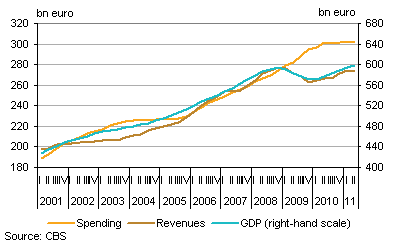No decrease for government deficit

The Dutch government spent 16.5 billion euro more than it received in the first half of 2011. This deficit is about the same as in the first half of 2010. The government debt continued to rise steadily in the first half of 2011.
Government surplus/deficit

Government deficit equals 5 percent
Government deficit in the Netherlands amounted to 16.5 billion euro in the first half of 2011. This means that on an annual basis the deficit came to 5 percent of gross domestic product (GDP). This is around the same level as the deficit in 2010, which was 5.1 percent of GDP. The negative gap between revenues and outlays was largest at the beginning of 2010, when it was around 6 percent.
The social funds had a deficit of 9 billion euro in the first half of this year, while central government had a shortfall of 8 billion euro. Central government is usually the government level with the largest deficits. The social funds face ever increasing spending on benefits and care that is not covered by revenues from premiums.
Debt 63.8 percent of GDP
Government debt also continued to climb steadily in 2011; at the end of the first half of the year it amounted to 63.8 percent of GDP. This was 1.0 percentage point up on the end of 2010. The reason for the increase was the high government deficit that had to be financed. The 4.5 billion euro in repayments of government loans to ING and Aegon were used to finance part of the government deficit. This curbed the increase in the debt to some extent. The government debt amounted to nearly 383 billion euro at the end of June.
Dutch government deficit and government debt are still well above the European norms. According to these norms, the deficit should not be in excess of 3 percent of GDP, while the debt should be 60 percent of GDP at the most.
Government deficit and government debt

Government spending levelling off
Government spending has hardly risen in the last four quarters, although the government did spend 10 percent more in the first half of the year than when the crisis started at the end of 2008. Government revenues, which usually follow GDP closely, were a few percent under the level of 2008.
Government spending and revenues

Léonard Haakman